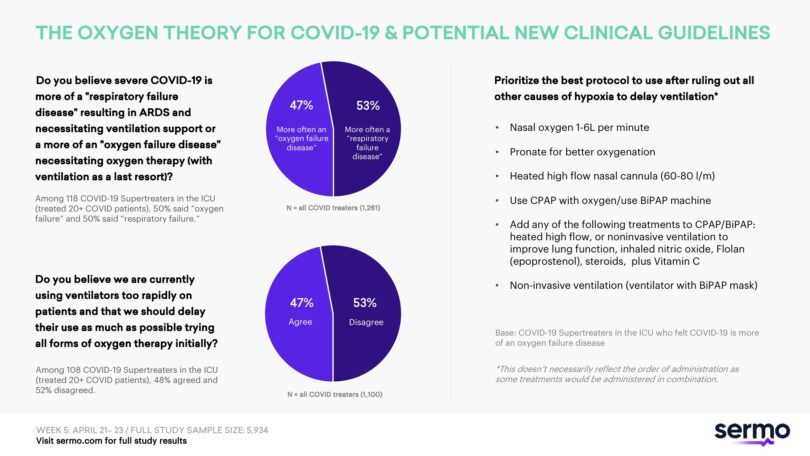According to the largest healthcare data collection company in the world, 50% of highly experienced COVID treaters believe COVID-19 is more of an “Oxygen Failure” Disease vs. a Respiratory Disease leading to ARDS. Sermo reaches 1.3 million Health Care Providers across 150 countries. They collect data and provide a social platform for physicians. The platform enables doctors to talk anonymously about real-world medicine, review treatment options, collectively solve patient cases, and participate in medical market research.
Sermo reported this week that their COVID-19 Real Time Barometer showed that over 5,900 physicians explored whether COVID 19 was a new type of disease, discussed the controversial use of ventilators, as well as the new protocols that could change the way physicians treat COVID-19. In total, Sermo’s Barometer study included over 27,000 survey interviews in 31 countries, including the United States, Canada, United Kingdom, France, Brazil, Russia, China, Japan and Australia. The Sermo published data and methodology can be found here.
Knowledge of COVID-19 and the optimal treatment approach is evolving, and some voices on the front lines have relayed they are charting unfamiliar territory and broadcasting concerns over treatment approaches, particularly the use of ventilators. The statistics around the breathing device are sobering. In NY, the Journal of the American Medical Association (JAMA) showed that up to 88% of those placed on ventilators died. “Panic buying of ventilators” and competition among states to procure ventilators was intense at the onset of the COVID-19 outbreak.
Dr. Cameron Kyle-Sidell, a New York-based ER and critical care physician widely broadcast a compelling message on YouTube, “we are treating the wrong disease.” We wanted to further probe his theory and formulated structured questions which were later taken to thousands of international physicians on the front lines.
“Nine days ago I opened an intensive care unit to care for the sickest COVID patients. In these 9 days I’ve seen things I’ve never seen before. I presumed I was opening an ICU to treat patients with a virus causing pneumonia that started out mild –– and progressed in severity ultimately ending in acute respiratory distress syndrome or ARDS.
“I believe we are treating the wrong disease.”
— Dr. Cameron Kyle-Sidell
“ARDS is the disease that every hospital is preparing to treat. And for which many patients might be put on a ventilator. And yet, everything I’ve seen in the last 9 days just doesn’t make sense… I believe we are treating the wrong disease. COVID-19 lung disease…is not a pneumonia and should not be treated as one. Rather, it appears as if it’s some kind of viral-induced disease most resembling high altitude sickness…as if (patients) are on a plane at 30,000 feet and the cabin pressure is slowly being let out. These patients are being starved of oxygen…they eventually get blue in the face, and while they look like patients on the brink of death, they do not look like patients dying of pneumonia…they look more like (they were) dropped off at the top of Mount Everest without time to acclimate.”

Ventilator use supplies more oxygen to patients who experience respiratory failure.
“I don’t know the final answer to this disease but I’m quite sure that a ventilator is not it. That is not to say that we don’t need ventilators, they are the only way at this time that we are able to give a little more oxygen to patients who need it. But when we treat ARDS, we typically use ventilators to treat respiratory failure, the ventilator does the work that the patients’ muscles can no longer do because they are too tired. These patients’ muscles work fine. I fear that if we are using a false paradigm to treat a new disease that the method that we program the ventilator, one based on a notion of respiratory failure as opposed to oxygen failure, (and there are a great many number of methods we can use with the ventilator), a method being widely adopted in every hospital in the country which aims to increase pressure on the lungs in order to open them up, is actually doing more harm than good…the pressure we are providing to lungs, may not be able to take it, and that the ARDS that we are seeing, may be nothing more than lung injury caused by the ventilator. Now, I don’t know the final answer to this disease. I do sense that we will have to use ventilators, but in a safer way. That safer method challenges long-held dogmatic beliefs within the medical community and among lung specialists which will not be easy to overcome.”
“I don’t know the final answer to this disease but I’m quite sure that a ventilator is not it.” — Dr. Cameron Kyle-Sidell
In our analysis of results from this past week, we focused on the responses from all physicians treating COVID as well as “COVID Supertreaters in the ICU” (physicians who have treated over 20 COVID-19 patients) and presumably would have the most educated opinions on the matter.
Using ventilation too rapidly?
Do you believe we are currently using ventilators too rapidly on patients and that we should delay their use as much as possible trying all forms of oxygen therapy initially?
- From the perspective of COVID-19 Supertreaters in the ICU (physicians who treat over 20 COVID-19 patients) and presumably would have the most experience with ventilators, 48% agreed and 52% disagreed. (n=108 COVID Supertreaters)
- Among all COVID-19 treating physicians in the study who expressed an opinion (n=1,100), 47% agreed and 53% disagreed
“My theory on the split in opinions is that in the beginning of this outbreak, patients were coming in and deteriorating so rapidly that healthcare providers were rushing to help patients breathe in whatever way we could,” said Dr. Mark Rumbak, Sermo physician and pulmonologist. “We are starting to rethink this.”
Does COVID-19 result in typical acute respiratory distress syndrome (ARDS)?
Do you believe severe COVID-19 is more of a “respiratory failure disease” resulting in ARDS and necessitating ventilation support or a more of an “oxygen failure” disease necessitating oxygen therapy (with ventilation as a last resort)?
- Among Supertreaters in the ICU, we had an equal split of opinions: 50% believed in the oxygen failure approach vs. 50% respiratory failure (n=118 COVID-19 Supertreaters).
- Again, among all COVID treating physicians in the study who expressed an opinion (n=1,261), 47% believed in the oxygen failure approach vs. 53% respiratory failure.
The two are results related; 63% of physicians who believed COVID-19 to be more of an oxygen failure disease also believed we are using ventilators too rapidly.

55% of global physicians use Hydroxychloroquine, 24% use Tocilizumab, 21% use Remdesivir, and 17% use Plasma.
“What’s highly significant here is that there should be almost unanimous opinion on these topics as we have accepted guidelines for what works and doesn’t with respect to Acute Respiratory distress Syndrome (ARDS). If this is not ARDS the treatment may be completely different. In the case of ARDS we need high Peep and low Fio2, if it’s not ARDS, we need the opposite approach,” said Dr. Rumbak. “Additionally, ARDS has specific histological results. There have been no biopsy results (acutely or post mortem) published as yet. This may be because hospital departments have been closed down for most except COVID-19. If they do publish, we will know what type of respiratory failure this is.”
Anonymous pulmonologist Sermo member “It could be a mix of both, perhaps we need to treat that oxygen failure much earlier, more rapidly and with diverse oxygen therapies.”
How many succeed on ARDS treatments?
In what percent of patient cases with COVID-19 and severe hypoxia does COVID-19 respond to regular ARDS treatments like intubation, high positive end-expiratory pressure (PEEP), lower fraction of inspired oxygen (FiO2)?
Only 17% of physicians felt that the majority of patients (60% – 100%) respond to ARDS strategies.
So what’s the alternative?
We explored other treatments and drugs that could be used to improve oxygenation/ delay intubation. Again, we report on COVID Supertreaters in the ICU.
If you believe oxygen is necessary for COVID-19 induced hypoxia, which treatments or drugs do you believe may be helpful in improving oxygenation and delaying intubation?
| High flow oxygen | Cpap or Bipap | High-dose steroids | Mucomyst (Acetylcysteine) | Vitamin C | Inhaled nitric oxide | Flolan (Epoprostenol Sodium) | Other |
| 81% | 64% | 29% | 8% | 19% | 19% | 10% | 2% |

Some symptoms of Acute Respiratory Distress Syndrome (ARDS) • Severe shortness of breath • Laboured and unusually rapid breathing • Low blood pressure • Confusion • Extreme tiredness.
There are alternative oxygen therapies that aren’t standard protocol for COVID-19 patients but are starting to see some use. The ECMO machine (extracorporeal membrane oxygenation), also known as extracorporeal life support, is an extracorporeal technique of providing prolonged cardiac and respiratory support to persons whose heart and lungs are unable to provide an adequate amount of gas exchange or perfusion to sustain life. Hyperbaric oxygen therapy involves breathing pure oxygen in a pressurized room or tube and is a well-established treatment for decompression sickness from scuba diving, serious infections, bubbles of air in the blood vessels and non-healing wounds resulting from diabetes or radiation.
“ECMO is an alternative and is used when P/F ratio drops below 80. Although there are less ECMO machines than ventilators they will decrease the amount of ventilators used. Some patients can be extubated while on ECMO and the ventilators used on other patients. ECMO may save lives. ECMO machines are the same machines used in cardiac surgery. As most routine cardiac surgical cases are not being performed due to COVID, they can be used in the ICU. Perhaps we could also use hyperbaric chambers although there are not too many of these. We could try to increase their supply. Some have suggested using the many idle airplanes we have and pressurizing the cabins produce “hyperbaric” oxygen. Many patients can be treated in one plane safely,” said Dr. Rumbak.
How helpful would each of these be as alternative oxygen therapies?
Highly Helpful” (Very/Extremely Helpful) Among COVID Treaters:
| Hyperbaric oxygen | ECMO |
| 28% (n = 396 COVID treaters with opinion on Hyperbaric oxygen) | 44% (n = 467 COVID treaters with opinion on ECMO) |
“Highly Helpful” (Very/Extremely Helpful) Among COVID Supertreaters in the ICU:
| Hyperbaric oxygen | ECMO |
| 31% (n = 45 COVID Supertreaters in the ICU with opinion on Hyperbaric oxygen) | 39% (n = 54 COVID supertreaters in the ICU with opinion on ECMO) |
A new protocol to delay ventilation?
We asked the physicians who felt COVID-19 is more of an oxygen failure issue to build a protocol where they ordered eight different oxygen strategies presented in order of priority to delay intubation. We asked physicians to place these strategies in order of what would be the best protocol to use after ruling out all other causes of hypoxia (heart failure, blood clot, cirrhosis, collapsed lung, shunts heart damage).
Overall this was the order of top priority for the following strategies, however, this doesn’t necessarily reflect the order of administration as some treatments would be administered in combination.
- Use nasal oxygen 1-6L per minute
- Pronate for better oxygenation
- Heated high flow nasal cannula 60-80 l/m
- Use Cpap with oxygen/use Bipap machine
- Add any of the following treatments to Cpap/Bipap/heated high flow, or non invasive ventilation to improve lung function: inhaled nitric oxide, Flolan (epoprostenol), steroids, plus Vitamin C
- Non-invasive ventilation (ventilator with Bipap mask)

There is more to COVID19 than we are aware at present, both with the disease and the political scene behind the draconian approach to fixing the problems of the disease. In time, we will find the answers and hold those responsible for the recent destruction of life and culture to account.

Please visit our sponsors and donate to support The Standard on this page.



 RSS - Posts
RSS - Posts